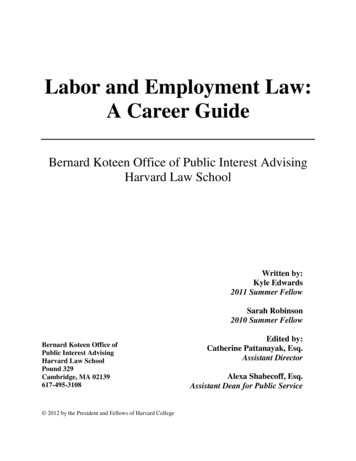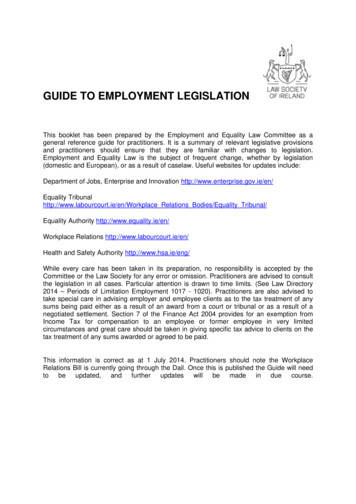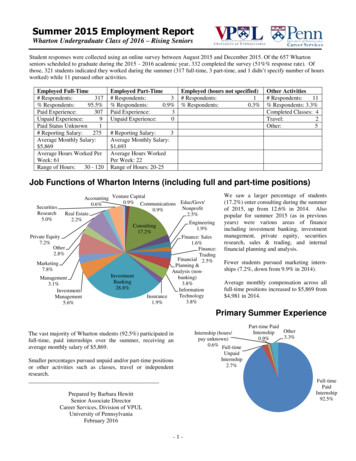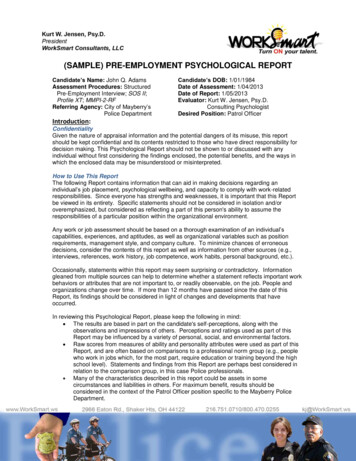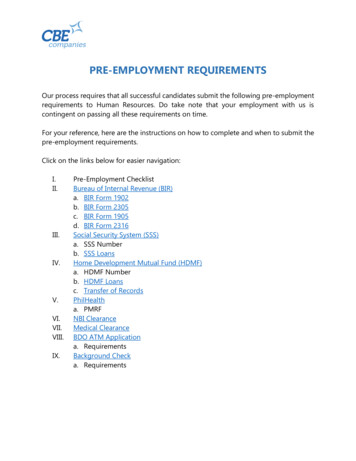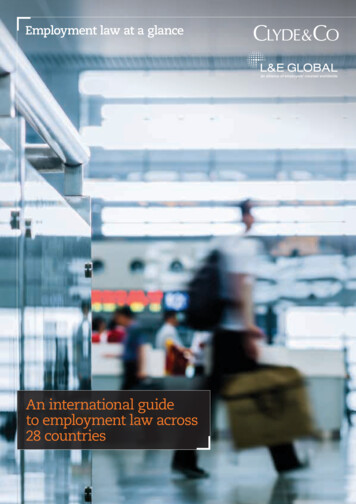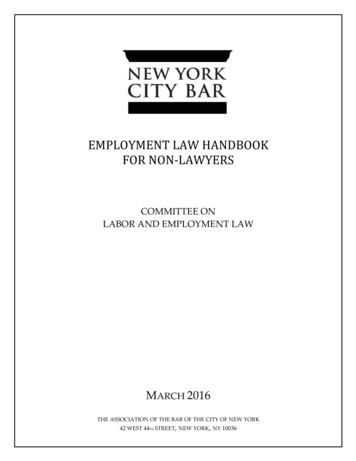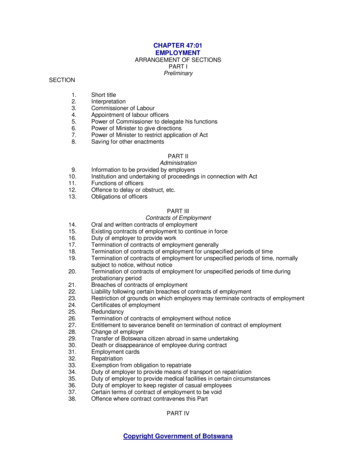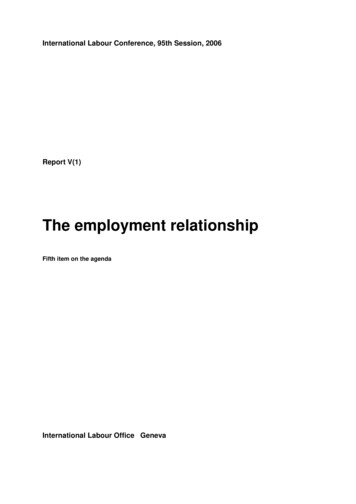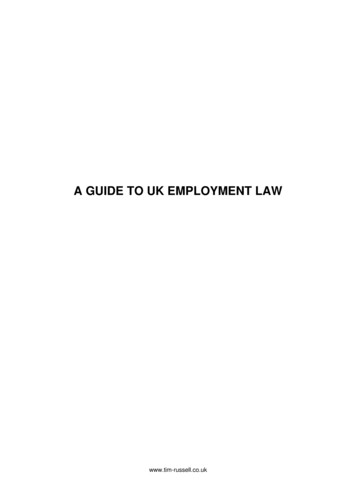
Transcription
A GUIDE TO UK EMPLOYMENT LAWwww.tim-russell.co.uk
CONTENTSPageA.INTRODUCTION11.Sources of UK employment law12.Types of worker in the UK23.UK employment courts3B.IMMIGRATION REQUIREMENTS31.Overview32.Work permit requirements33.Work permit applications44.Highly skilled migrant programme65.The Science and Engineering Graduate Scheme66.Employing illegal workers6C.CONTRACTUAL TERMS71.Overview72.Express terms73.Implied terms94.Varying terms10D.RIGHTS DURING EMPLOYMENT101.Overview102.Hours of work103.Salary and benefits114.Pensions125.Holidays136.Sick pay137.Maternity leave148.Paternity leave149.Adoption leave1510.Parental leave15
11.Time off for dependants1612.Flexible working1613.Union membership1714.Data protection rights1715.Disciplinary and grievance procedures1916.Monitoring/surveillance2017.Health and safety2118.Whistleblowing2219.The Protection from Harassment Act 199723E.TERMINATION OF EMPLOYMENT231.Overview232.Wrongful dismissal233.Unfair dismissal244.Dismissal procedures265.Redundancy payments286.Written reason for dismissal287.Settling employees’ claims on termination298.Enforcing post termination restrictions29F.DISCRIMINATION301.Overview302.Sex discrimination303.Equal pay314.Race discrimination315.Disability discrimination326.Sexual orientation discrimination337.Discrimination on the grounds of religion or belief338.Part time workers33
9.Fixed term workers3410.Age Discrimination35G.BUSINESS TRANSFERS351.Overview352.Application of TUPE353.Effect of TUPE364.Information and consultation requirements375.Occupational pension arrangements386.Other proposed amendments to TUPE38H.COLLECTIVE RIGHTS391.Overview392.Trade union recognition393.Consultation on collective redundancies404.Consultation on business transfers415.Consultation on health and safety issues426.Works Councils427.National Works Councils42USEFUL WEBSITES45
A.INTRODUCTION1.SOURCES OF UK EMPLOYMENT LAWThere are three main sources of UK employment law: the common law, statute and Europeanlaw (in the form of both European Directives and decisions of the European Court of Justice).1.1Common law. Since all employees in the UK work under a contract of employment with theiremployer, the common law (particularly the law of contract) forms the legal basis of theemployer/employee relationship. A contract of employment need not be but is usuallyrecorded in writing. The parties are free to stipulate which law will be the governing law of thecontract. However, certain mandatory statutory employment protection rights will applyregardless of the law of the contract. In addition, the law of tort will govern matters such asan employer’s liability for the acts of its employees and liability for industrial accidents.1.2Statute. Since the early 1970s there has been a dramatic growth in the amount of UKemployment protection legislation which has supplemented the common law rules. The mainemployment law statutes are:Equal Pay Act 1970Health & Safety at Work etc Act 1974Sex Discrimination Act 1975Race Relations Act 1976Trade Union and Labour Relations (Consolidation) Act 1992Disability Discrimination Act 1995Employment Tribunals Act 1996Employment Rights Act 1996Public Interest Disclosure Act 1998Data Protection Act 1998National Minimum Wage Act 1998Human Rights Act 1998Employment Relations Act 1999Employment Act 2002Employment Relations Act 2004Disability Discrimination Act 2005In addition, there is a substantial amount of secondary legislation in the form of regulationswhich contain further provisions which affect the employment relationship. In some cases thelegislation is supported by Codes of Practice drawn up by various government agencies.Although the Codes do not have direct legal effect, they are often, and in some cases have tobe, taken into account by Employment Tribunals when deciding whether an employer hascomplied with its statutory obligations.1.3European law. If UK domestic law has failed properly to implement EC Treaty obligations,individuals may rely on the EC Treaty in the UK courts. EC legislation has been particularlyimportant in the areas of equal pay, discrimination and employees’ rights on businesstransfers. In addition, since the European Court of Justice is the final arbiter in matters ofinterpretation of European legislation, its judgments are important when it comes to questionsrelating to the interpretation of obligations derived from European Directives.1
GUIDE TO UK EMPLOYMENT LAW2.TYPES OF WORKER IN THE UKThere have traditionally been three main categories of worker in the UK: self-employedindependent contractors, agency workers or temps, and employees, with each categoryenjoying different employment protection rights. In recent years, however, a fourth category,‘workers’ has been established. Confusingly, this category overlaps with the others.2.1Independent Contractors. In essence, an independent contractor is someone who is inbusiness on their own account and who is responsible for making their own decisions as tohow the job is performed. There are advantages for both the employer and the individual inhaving a relationship of this nature; the employer is freed from most statutory employmentprotection legislation, and the individual enjoys a favourable tax position. However, thesetypes of relationship have come under increasingly closer scrutiny by the courts and HMRevenue & Customs (HMRC) (formerly the Inland Revenue). The fact that an individual islabelled an independent contractor by both parties to the relationship is not the determiningfactor. Current decisions suggest that the most important considerations are whether there ismutuality of obligations and an obligation on the part of the contractor to do the workpersonally. If there is, then the court and/or HMRC is likely to find that the relationship isactually one of employer/employee.2.2Agency Workers. Some workers are employed or engaged by an employment agencywhich then supplies their services to the hirer. Although the hirer will owe certain statutoryduties (e.g. duties under the discrimination and health and safety legislation) it will not owethe agency worker many of the employment protection rights enjoyed by employees. Agencyworkers are generally used for temporary engagements although it is not uncommon forengagements to last for several months or even years. Case law has emphasised, however,that if an agency worker is used by a hirer for an extended period, and other facts point to anemployer/employee relationship, the agency worker may be able to claim employment rightsdirectly against the hirer (even if there is no contract directly between the agency worker andthe hirer).2.3Employees. The majority of workers in the UK are employees of the company to which theyprovide their services. Unlike in some EU countries, there is no legal distinction between bluecollar workers, white collar workers and senior directors, other than whatever may be writteninto their employment contracts. The basic principles of the common law and statutoryemployment protection legislation apply to all employees regardless of their status. As longas they satisfy the relevant qualifying conditions, employees will benefit from greater statutoryemployment protection rights than independent contractors and agency workers. Inparticular, after one year’s service, an employee will benefit from the right not to be unfairlydismissed.2.4Workers. The idea of a separate legal category of ‘workers’ is a relatively new one in UKlaw. The concept derives from European law. In broad terms, a worker is someone whoworks under an employment contract, or some other contract under which they agree toprovide services personally. In addition, to qualify as a worker the organisation to which theindividual is providing their services must not be a client/customer of their profession orbusiness. So, for example, some independent contractors may qualify as workers. Workersenjoy fewer rights than ‘full’ employees, but still benefit from, for example, rights relating to thenumber of hours they work, the amount of annual leave they can take, and the amount theyare paid.2
GUIDE TO UK EMPLOYMENT LAW3.UK EMPLOYMENT COURTSThere are three forums which decide legal disputes between a worker and whoever employsthem: Employment Tribunals, the common law courts (the High Court or County Court) andthe recently introduced arbitration scheme operated by a government body called theAdvisory Conciliation & Arbitration Service (“ACAS”).3.1Employment Tribunals. These are specialist employment courts which hear the majority ofdisputes which arise between employers and the staff they engage. They deal mainly withclaims brought under the employment protection legislation such as unfair dismissal anddiscrimination claims. They also have jurisdiction to hear contractual claims (subject to amaximum award of 25,000) provided the claim arises or is outstanding on the termination ofemployment. Employment Tribunals usually comprise three members: a legally qualifiedchair and two lay members (one from a Trade Union background and one from amanagement background). Their decisions can be appealed to the Employment AppealsTribunal.3.2Common law courts. An employee who wishes to bring a contractual claim (such as fornotice pay) may elect to pursue it in either the High Court or the County Court instead of theEmployment Tribunal. In general, a claim may only be brought in the High Court if its value ismore than 15,000. The process in the High Court and the County Court tends to be moreformal and lengthy than in the Employment Tribunal, although the successful party canusually recover most of their costs from the unsuccessful party, which they cannot in theEmployment Tribunal.3.3stACAS Arbitration Scheme. This is a voluntary scheme which came into force on 21 May2001 and is intended to provide a faster, non-legalistic and more cost effective alternative toEmployment Tribunals. It is currently only available for the resolution of straightforward unfairdismissal complaints, and in relation to flexible working disputes. Both parties must agree toopt for the scheme. The hearing is conducted in private before a single ACAS arbitrator whomay award exactly the same remedies as would be available from an Employment Tribunal.B.IMMIGRATION REQUIREMENTS1.OVERVIEWWith limited exceptions, a non-EEA national who is subject to immigration control must obtaina work permit to be able to take up employment in the UK. The UK work permit scheme isadministered by Work Permits (UK) on behalf of the Home Office. In January 2002, theHome Office launched the Highly Skilled Migrant Programme (see page 6). There areproposals to discard the work permit scheme and replace it with a simpler points basedsystem in the future.2.2.1WORK PERMIT REQUIREMENTSWorkers who require a permit. Certain limited categories of persons do not require workpermits – these include nationals of the EEA, Commonwealth citizens with leave to enter orremain in the UK on the basis of recent UK ancestry, persons with indefinite leave to remainin the UK, Gibraltarians, business visitors and persons wishing to engage in certainspecified occupations (e.g. ministers of religion and representatives of overseas firms whoare seeking to establish a UK branch or subsidiary). All other foreign workers must hold avalid work permit in order to enter and work in the UK. A visa may also be necessary beforethe individual is allowed to enter the UK. In addition, all individuals entering the UK for astay of more than 6 months, with the exception of those coming from EEA member states,require prior entry clearance, which should be obtained after the work permit.3
GUIDE TO UK EMPLOYMENT LAW2.2Eligibility to apply. Work permit applications may only be made by employers based in theUK who need to employ a person in England, Scotland or Wales. Overseas companiescannot make applications, nor can individuals apply on their own behalf. The applicationshould be made for a named person to do a specific job, normally on a full-time basis.Permits are only issued for certain categories of skilled work, and are not issued for jobs atmanual, craft, clerical, secretarial or similar levels. Work permits are not transferablebetween employers unless permission is firstly sought from Work Permits (UK).2.3Work permit criteria. Work permit applications are considered against the following fourbasic criteria:3.(a)Whether there is a genuine vacancy for an employee in the UK.(b)The skills, qualifications and experience needed for the job – the nature of thejob itself must require the qualifications or skills listed in (c) below.(c)The qualifications and experience of worker – work permits are normally onlyissued for people who have one of the following qualifications or skills: a UKequivalent degree level qualification; a Higher National Diploma (HND) leveloccupational qualification which is relevant to the post on offer; a general HND levelqualification which is not relevant to the post on offer plus one year’s relevant workexperience; at least three years’ high level specialist skills acquired through doing thetype of job for which the permit is sought (the type of job being at NVQ level 3 orabove).(d)Availability of ‘resident workers’ – the employer will need to show why it cannot fillthe post with a suitably qualified ‘resident worker’ (i.e. a person who is an EEAnational or has settled status within the meaning of the Immigration Act 1971).Except in Tier 1 applications (see below) the employer will usually need to show thatit has advertised the vacancy appropriately: this will generally mean advertisementsin local, national and/or EEA press, and in any appropriate trade and professionaljournals or appropriate websites.WORK PERMIT APPLICATIONSApplication forms are available online from the Work Permits (UK) website (see page 45).Guidance notes for their completion, including further details of evidence to be furnished, arealso available
employer, the common law (particularly the law of contract) forms the legal basis of the employer/employee relationship. A contract of employment need not be but is usually recorded in writing. The parties are free to stipulate which law will be the governing law of the contract. However, certain mandatory statutory employment protection rights will applyFile Size: 307KBPage Count: 51

